EBIC Imaging of Conductive Paths Formed in Graphene Oxide as a Result of Resistive Switching
Abstract
1. Introduction
2. Materials and Methods
3. Results and Discussion
4. Conclusions
Author Contributions
Funding
Institutional Review Board Statement
Informed Consent Statement
Data Availability Statement
Conflicts of Interest
References
- Hanoka, J.I.; Bell, R.O. Electron-Beam-Induced Currents in Semiconductors. Ann. Rev. Mater. Sci. 1981, 11, 353–380. [Google Scholar] [CrossRef]
- Leamy, H.J. Charge collection scanning electron microscopy. J. Appl. Phys. 1982, 53, R51–R80. [Google Scholar] [CrossRef]
- Yakimov, E.B. Electron-beam-induced-current study of defects in GaN; Experiments and simulation. J. Phys. Condens. Matter. 2002, 14, 13069–13077. [Google Scholar] [CrossRef]
- Yakimov, E.B. Study of Wide-Gap Semiconductors Using Electron-Beam Induced Current Method. Crystallogr. Rep. 2021, 66, 581–593. [Google Scholar] [CrossRef]
- Donolato, C. Theory of beam induced current characterization of grain boundaries in polycrystalline solar cells. J. Appl. Phys. 1983, 54, 1314–1322. [Google Scholar] [CrossRef]
- Donolato, C. Modeling the effect of dislocations on the minority carrier diffusion length of a semiconductor. J. Appl. Phys. 1998, 84, 2656–2664. [Google Scholar] [CrossRef]
- Chen, J.; Sekiguchi, T.; Fukata, N.; Takase, M.; Chikyow, T.; Yamabe, K.; Hasunuma, R.; Akasaka, Y.; Inumiya, S.; Nara, Y.; et al. Observation of leakage sites in a hafnium silicon oxynitride gate dielectric of a metal-oxide-semiconductor field-effect transistor device by electron-beam-induced current. Appl. Phys. Lett. 2006, 89, 222104. [Google Scholar] [CrossRef]
- Chen, J.; Sekiguchi, T.; Fukata, N.; Takase, M.; Nemoto, Y.; Hasunuma, R.; Yamabe, K.; Sato, M.; Yamada, K.; Chikyow, T. An Electron-Beam-Induced Current Investigation of Electrical Defects in High-k Gate Stacks. ECS Trans. 2010, 28, 299–313. [Google Scholar] [CrossRef]
- Aris, F.C.; Davies, P.M.; Lewis, T.J. Electron-beam-induced conduction in dielectrics. J. Phys. C Solid State Phys. 1976, 9, 797–808. [Google Scholar] [CrossRef]
- Nakamae, K.; Fujioka, H.; Ura, K. Electron-beam-induced current in a chemical-vapour-deposited SiO2 passivation layer on an MOS structure with a non-penetrating electron beam. J. Phys. D Appl. Phys. 1991, 24, 963–968. [Google Scholar] [CrossRef]
- Hoskins, B.D.; Adam, G.C.; Strelcov, E.; Zhitenev, N.; Kolmakov, A.; Strukov, D.B.; McClelland, J.J. Stateful characterization of resistive switching TiO2 with electron beam induced currents. Nat. Commun. 2017, 8, 1972. [Google Scholar] [CrossRef] [PubMed]
- Belhaj, M.; Jbara, O.; Filippov, M.N.; Rau, E.I.; Andrianov, M.V. Analysis of two methods of measurements of surface potential of insulators in SEM: Electron spectroscopy and X-ray spectroscopy methods. Appl. Surf. Sci. 2001, 177, 58–65. [Google Scholar] [CrossRef]
- Zhang, H.-B.; Feng, R.-J.; Ura, K. Utilizing the charging effect in scanning electron microscopy. Sci. Prog. 2004, 87, 249–268. [Google Scholar] [CrossRef] [PubMed]
- Vergeles, P.S.; Kulanchikov, Y.O.; Yakimov, E.B. Charging Effects in Al-SiO2-p-Si Structures After Low-Energy Electron Beam Irradiation. J. Electron. Mater. 2020, 49, 5178–5183. [Google Scholar] [CrossRef]
- Ding, Z.J.; Li, C.; Da, B.; Liu, J. Charging effect induced by electron beam irradiation: A review. Sci. Technol. Adv. Mater. 2021, 22, 932–971. [Google Scholar] [CrossRef]
- Rau, E.I.; Tatarintsev, A.A. Modification of the model of charging dielectrics under electron beam irradiation. J. Appl. Phys. 2022, 132, 184102. [Google Scholar] [CrossRef]
- Rossel, C.; Meijer, G.I.; Brémaud, D.; Widmer, D. Electrical current distribution across a metal–insulator–metal structure during bistable switching. J. Appl. Phys. 2001, 90, 2892–2898. [Google Scholar] [CrossRef][Green Version]
- Regan, B.C.; Lodico, J.; Hubbard, W.A. Scanning TEM EBIC Imaging of Resistive Memory Switching Processes. Microsc. Microanal. 2018, 24 (Suppl. S1), 1806–1807. [Google Scholar] [CrossRef]
- Sun, W.; Gao, B.; Chi, M.; Xia, Q.; Yang, J.J.; Qian, H.; Wu, H. Understanding memristive switching via in situ characterization and device modeling. Nat. Commun. 2019, 10, 3453. [Google Scholar] [CrossRef]
- Yi, W.; Chen, J.; Sekiguchi, T. Electron-Beam-Induced Current and Cathodoluminescence Study of Dislocations in SrTiO3. Crystals 2020, 10, 736. [Google Scholar] [CrossRef]
- Koveshnikov, S.; Kononenko, O.; Soltanovich, O.; Kapitanova, O.; Knyazev, M.; Volkov, V.; Yakimov, E. Multiple Resistive Switching Mechanisms in Graphene Oxide-Based Resistive Memory Devices. Nanomaterials 2022, 12, 3626. [Google Scholar] [CrossRef]
- Wu, H.; Wang, X.H.; Gao, B.; Deng, N.; Lu, Z.; Haukness, B.; Bronner, G.; Qian, H. Resistive Random Access Memory for Future Information Processing System. Proc. IEEE 2017, 105, 1770–1789. [Google Scholar] [CrossRef]
- Hong, H.; Loy, D.J.; Dananjaya, P.A.; Tan, F.; Ng, C.; Lew, W. Oxide-based RRAM materials for neuromorphic computing. J. Mater. Sci. 2018, 53, 8720–8746. [Google Scholar] [CrossRef]
- Cai, F.; Yen, S.-H.; Uppala, A.; Thomas, L.; Liu, T.; Fu, P.; Zhang, X.; Low, A.; Kamalanathan, D.; Hsu, J.; et al. A Fully Integrated System-on-Chip Design with Scalable Resistive Random-Access Memory Tile Design for Analog in-Memory Computing. Advanc. Intellig. Syst. 2022, 4, 2200014. [Google Scholar] [CrossRef]
- Waser, R.; Aono, M. Nanoionics-based resistive switching memories. Nat. Mater. 2007, 6, 833–840. [Google Scholar] [CrossRef]
- Kwon, J.; Sharma, A.; Chen, C.-Y.; Fantini, A.; Jurczak, M.; Herzing, A.; Bain, J.; Picard, Y.; Skowronski, M. Transient thermometry and high resolution transmission electron microscopy analysis of filamentary resistive switchers. ACS Appl. Mater. Interfaces 2016, 8, 20176–20184. [Google Scholar] [CrossRef] [PubMed]
- Kumar, S.; Graves, C.; Strachan, J.; Grafals, E.; Kilcoyne, A.; Tyliszczak, T.; Weker, J.; Nishi, Y.; Williams, S. Direct observation of localized radial oxygen migration in functioning tantalum oxide memristors. Adv. Mater. 2016, 28, 2772–2776. [Google Scholar] [CrossRef]
- Celano, U.; Goux, L.; Degraeve, R.; Fantini, A.; Richard, O.; Bender, H.; Jurczak, M.; Vandervorst, W. Imaging the three-dimensional conductive channel in filamentary-based oxide resistive switching memory. Nano Lett. 2015, 15, 7970–7975. [Google Scholar] [CrossRef]
- Yakimov, E.B. Electron beam induced excess carrier concentration. Phys. Status Solidi C 2017, 14, 1600266. [Google Scholar] [CrossRef]
- Porro, S.; Accornero, E.; Pirri, C.F.; Ricciardi, C. Memristive devices based on graphene oxide. Carbon 2015, 85, 383–396. [Google Scholar] [CrossRef]
- Romero, F.J.; Toral, A.; Medina-Rull, A.; Moraila-Martinez, C.L.; Morales, D.P.; Ohata, A.; Godoy, A.; Ruiz, F.G.; Rodriguez, N. Resistive Switching in Graphene Oxide. Front. Mater. 2020, 7, 17. [Google Scholar] [CrossRef]
- Brzhezinskaya, M.; Kapitanova, O.O.; Kononenko, O.V.; Koveshnikov, S.; Korepanov, V.; Roshchupkin, D. Large-scalable graphene oxide films with resistive switching for nonvolatile memory applications. J. Alloys Compd. 2020, 849, 156699. [Google Scholar] [CrossRef]
- Marcano, D.C.; Kosynkin, D.V.; Berlin, J.M.; Sinitskii, A.; Sun, Z.; Slesarev, A.; Alemany, L.B.; Lu, W.; Tour, J.M. Improve synthesis of graphene oxide. ACS Nano 2010, 4, 4806–4814. [Google Scholar] [CrossRef] [PubMed]
- Panin, G.N.; Kapitanova, O.O.; Lee, S.W.; Baranov, A.N.; Kang, T.W. Resistive switching in Al/graphene oxide/Al structure. Jpn. J. Appl. Phys. 2011, 50, 070110. [Google Scholar] [CrossRef]
- Rasheed, M.; Shihab, S.; Sabah, O.W. An investigation of the Structural, Electrical and Optical Properties of Graphene-Oxide Thin Films Using Different Solvents. J. Phys. Confer. Ser. 2021, 1795, 012052. [Google Scholar] [CrossRef]
- Zaitsev, S.I.; Pavlov, V.N.; Panchenko, V.Y.; Polikarpov, M.A.; Svintsov, A.A.; Yakimov, E.B. Comparison of the Efficiency of 63Ni Beta_Radiation Detectors Made from Silicon and Wide-Gap Semiconductors. J. Surf. Investig. 2014, 8, 843–845. [Google Scholar] [CrossRef]
- Svintsov, A.A.; Knyazev, M.A.; Zaitsev, S.I. Calculation of the Absorbed Electron Energy 3D Distribution by the Monte Carlo Method, Presentation of the Proximity Function by Three Parameters α, β, η and Comparison with the Experiment. Materials 2022, 15, 3888. [Google Scholar] [CrossRef] [PubMed]
- Torrisi, L.; Cutroneo, M.; Torrisi, A.; Silipigni, L. Measurements on Five Characterizing Properties of Graphene Oxide and Reduced Graphene Oxide Foils. Phys. Status Solidi A 2022, 219, 2100628. [Google Scholar] [CrossRef]
- Tyagi, C.; Lakshmi, G.B.V.S.; Kumar, S.; Tripathi, A.; Avasthi, D.K. Structural changes in graphene oxide thin film by electron-beam irradiation. Nuclear Instrum. Methods Phys. Res. B 2016, 379, 171–175. [Google Scholar] [CrossRef]
- de Lima, A.H.; Tavares, C.T.; da Cunha, C.C.S.; Vicentini, N.C.; Carvalho, G.R.; Fragneaud, B.; Maciel1, I.O.; Legnani, C.; Quirino, W.G.; de Oliveira, L.F.C.; et al. Origin of optical bandgap fluctuations in graphene oxide. Eur. Phys. J. B 2020, 93, 105. [Google Scholar] [CrossRef]
- Sharma, N.; Arif, M.; Monga, S.; Shkir, M.; Mishra, Y.K.; Singh, A. Investigation of bandgap alteration in graphene oxide with different reduction routes. Appl. Surface Sci. 2020, 513, 145396. [Google Scholar] [CrossRef]
- Yakimov, E.B.; Polyakov, A.Y.; Shchemerov, I.V.; Smirnov, N.B.; Vasilev, A.A.; Vergeles, P.S.; Yakimov, E.E.; Chernykh, A.V.; Ren, F.; Pearton, S.J. Experimental estimation of electron–hole pair creation energy in β-Ga2O3. Appl. Phys. Lett. 2021, 118, 202106. [Google Scholar] [CrossRef]
- Borisov, S.S.; Vergeles, P.S.; Yakimov, E.B. Investigations of Electron Beam Induced Conductivity in Silicon Oxide Thin Films. J. Surf. Investig. 2010, 4, 754–757. [Google Scholar] [CrossRef]
- Lin, Y.; Joy, D.C. A new examination of secondary electron yield data. Surf. Interface Anal. 2005, 37, 895–900. [Google Scholar] [CrossRef]
- Ji, S.; Min, B.K.; Kim, S.K.; Myung, S.; Kang, M.; Shin, H.-S.; Song, W.; Heo, J.; Lim, J.; An, K.-S.; et al. Work function engineering of grapheme oxide via covalent functionalization for organic field-effect transistors. Appl. Surf. Sci. 2017, 419, 252–258. [Google Scholar] [CrossRef]
- Ledra, M.; Tabet, N. Monte Carlo simulation of the EBIC collection efficiency of a Schottky nanocontact. Superlatt. Microstruct. 2009, 45, 444–450. [Google Scholar] [CrossRef]
- Doan, Q.T.; El Hdiy, A.; Troyon, M. Three-dimensional simulation of electron beam induced current collected by a nano-contact: Diffusion and collection analysis. J. Appl. Phys. 2011, 110, 124515. [Google Scholar] [CrossRef]
- Donolato, C. An Analytical Model of SEM and STEM Charge Collection Images of Dislocations in Thin Semiconductor Layers I. Minority Carrier Generation, Diffusion, and Collection. Phys. Status Solidi A 1981, 65, 649–658. [Google Scholar] [CrossRef]
- Donolato, C. Approximate analytical solution to the space charge problem in nanosized Schottky diodes. J. Appl. Phys. 2004, 95, 2184–2186. [Google Scholar] [CrossRef]
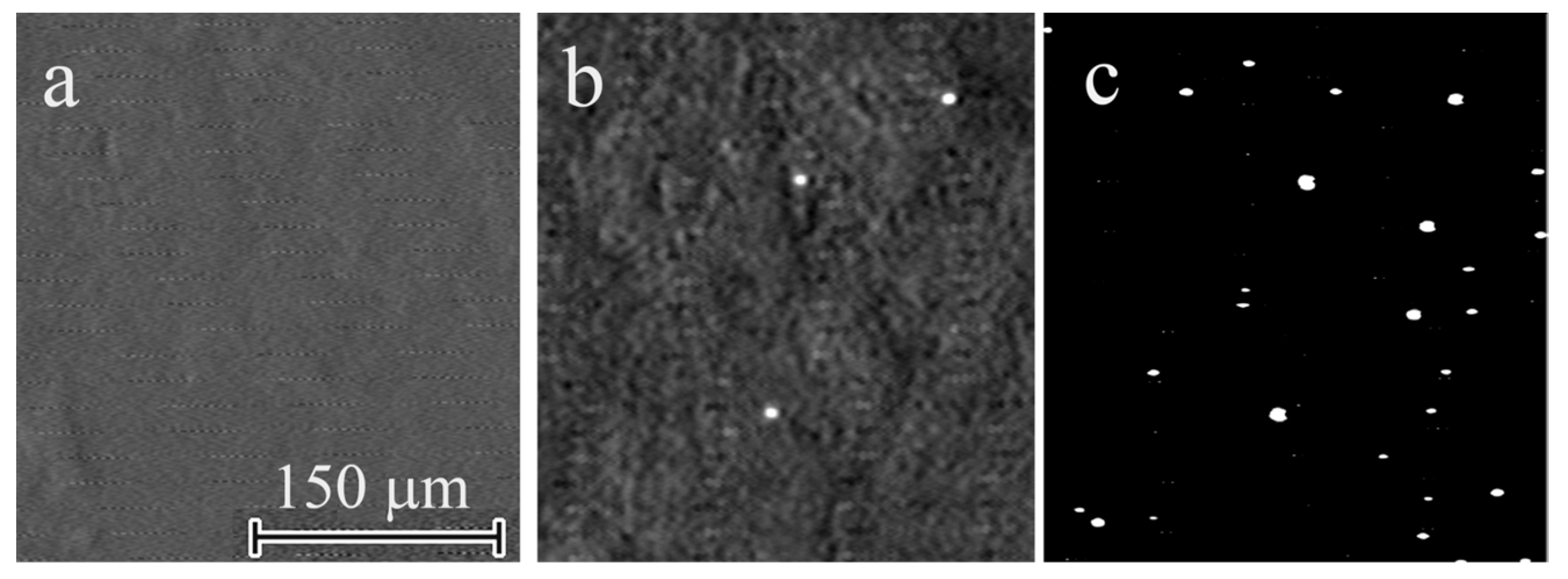
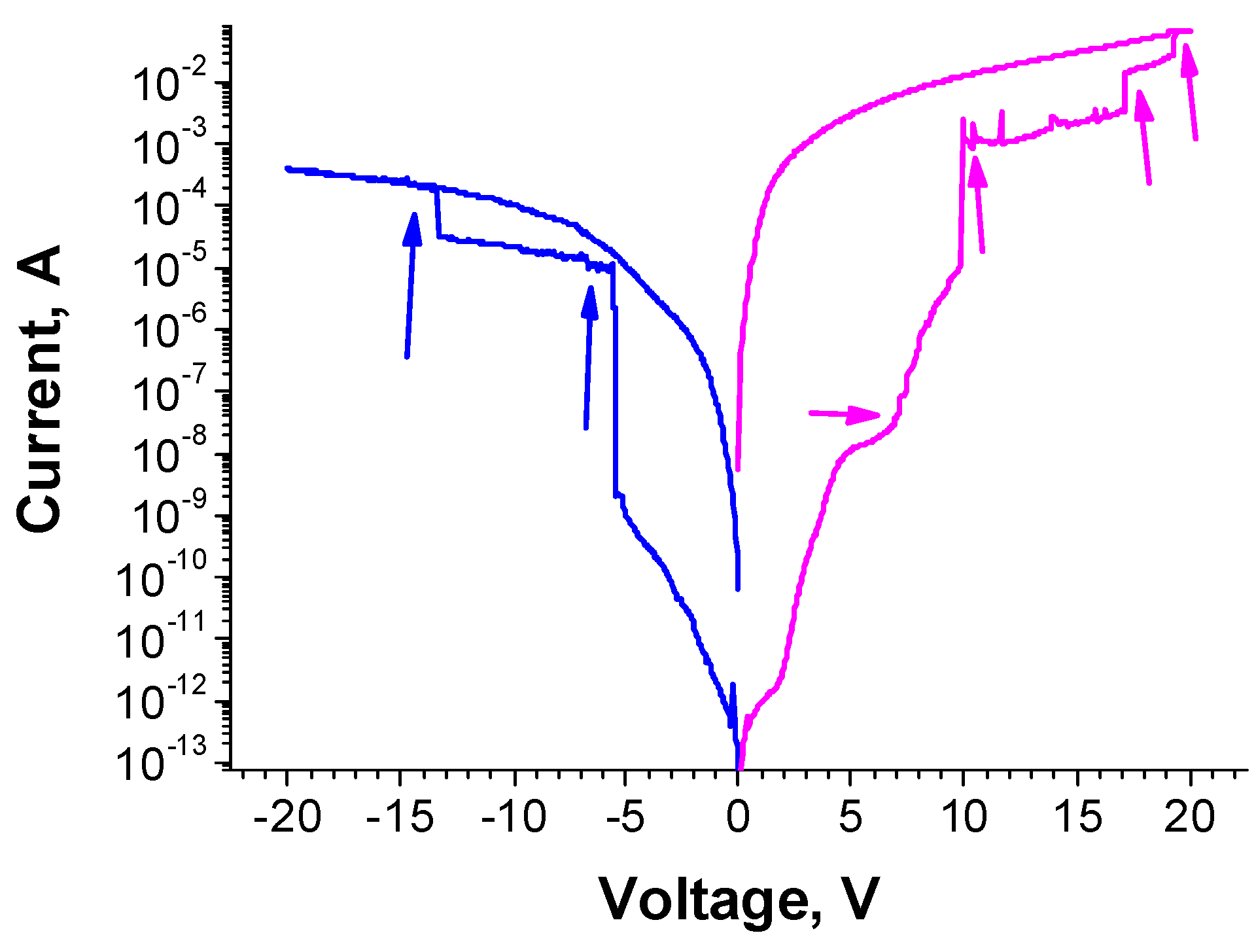
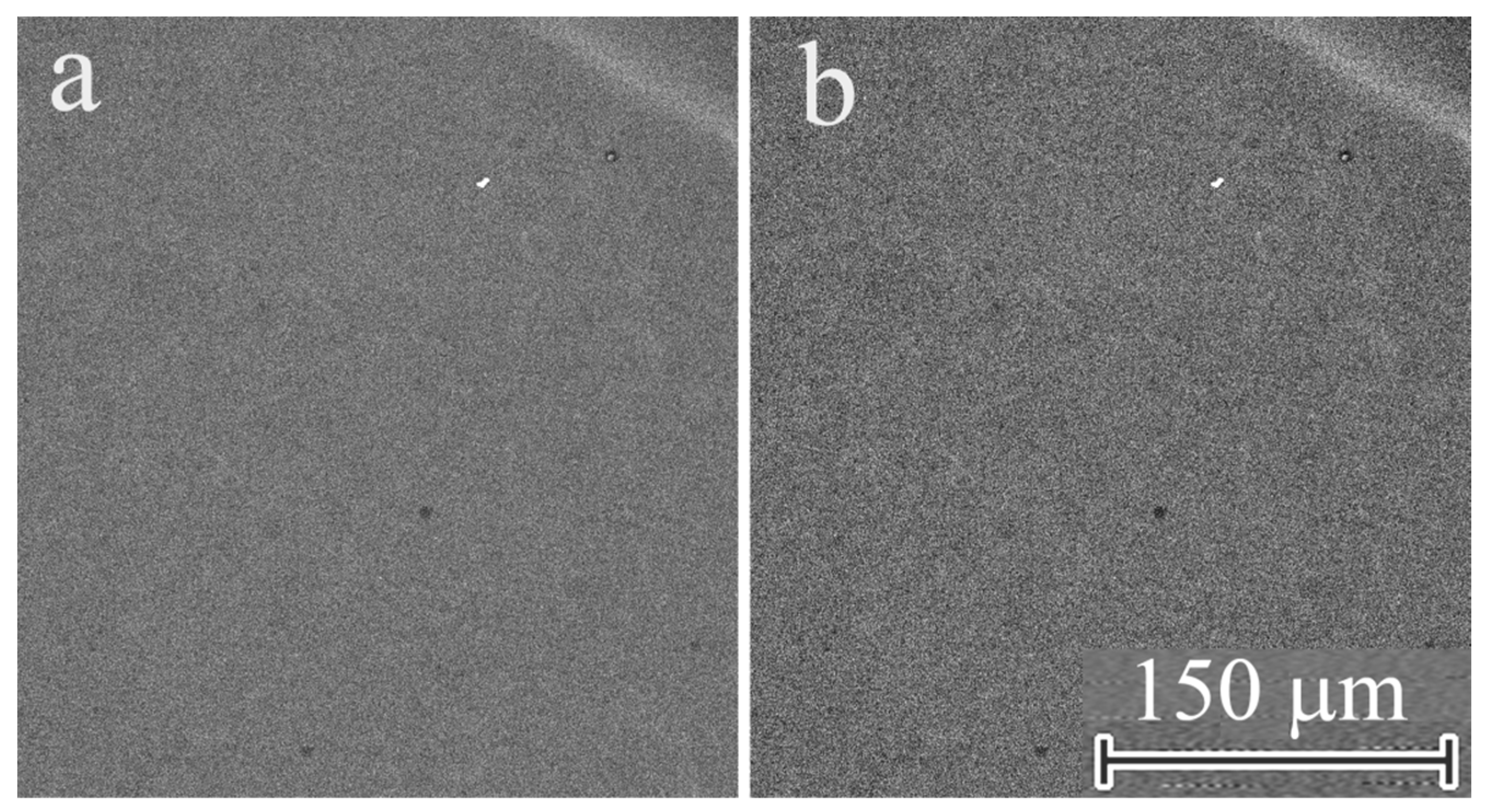

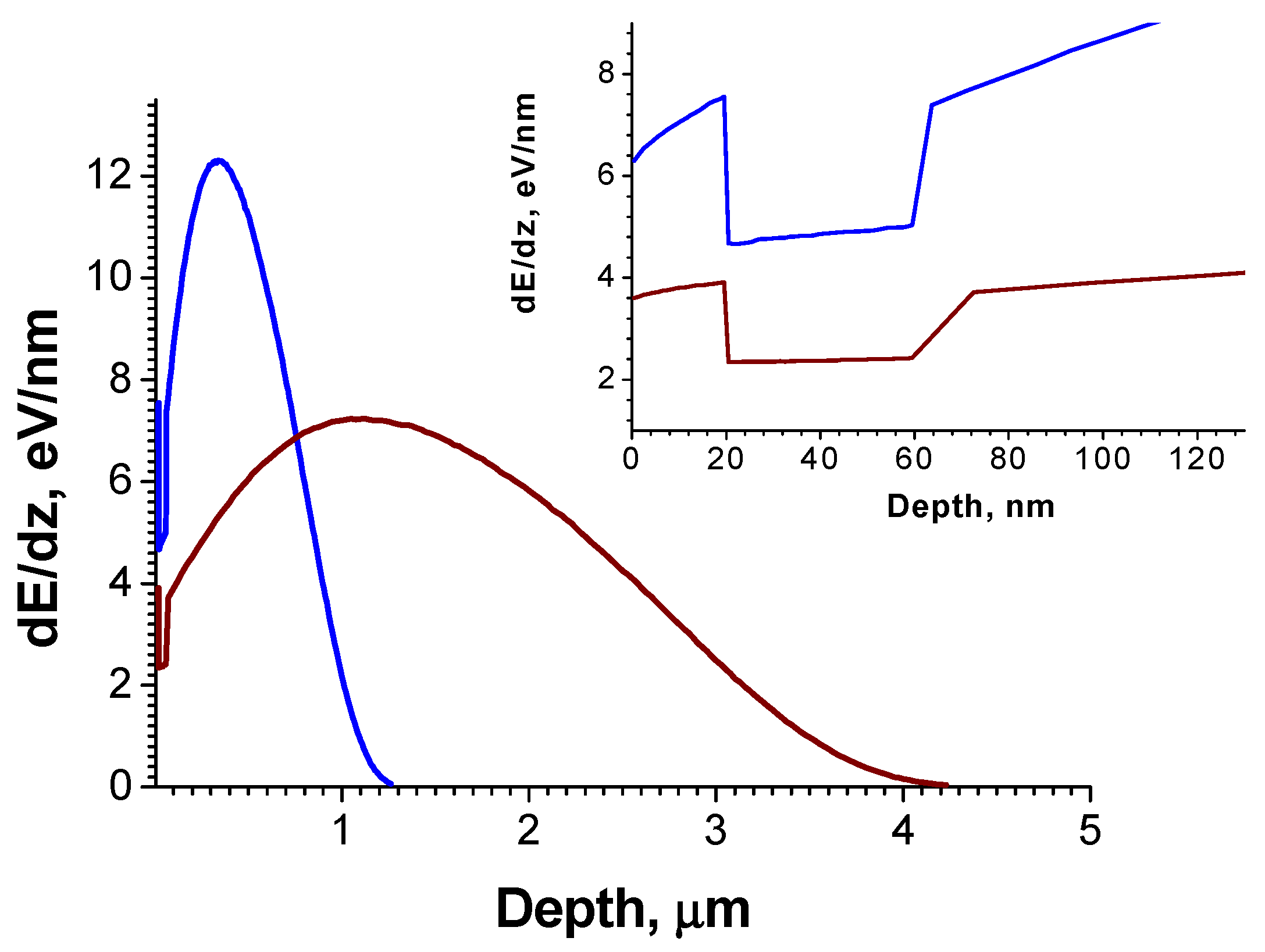

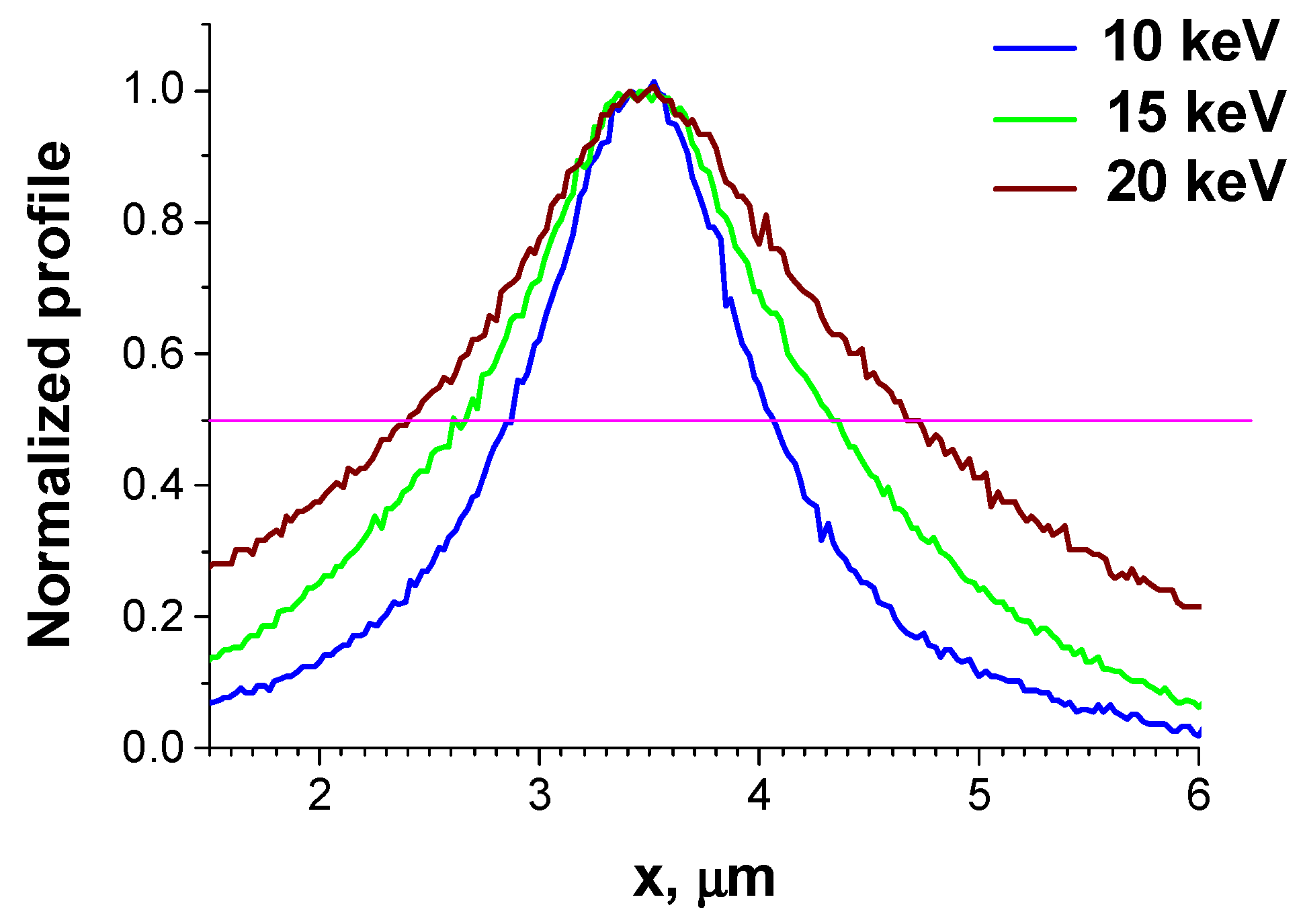
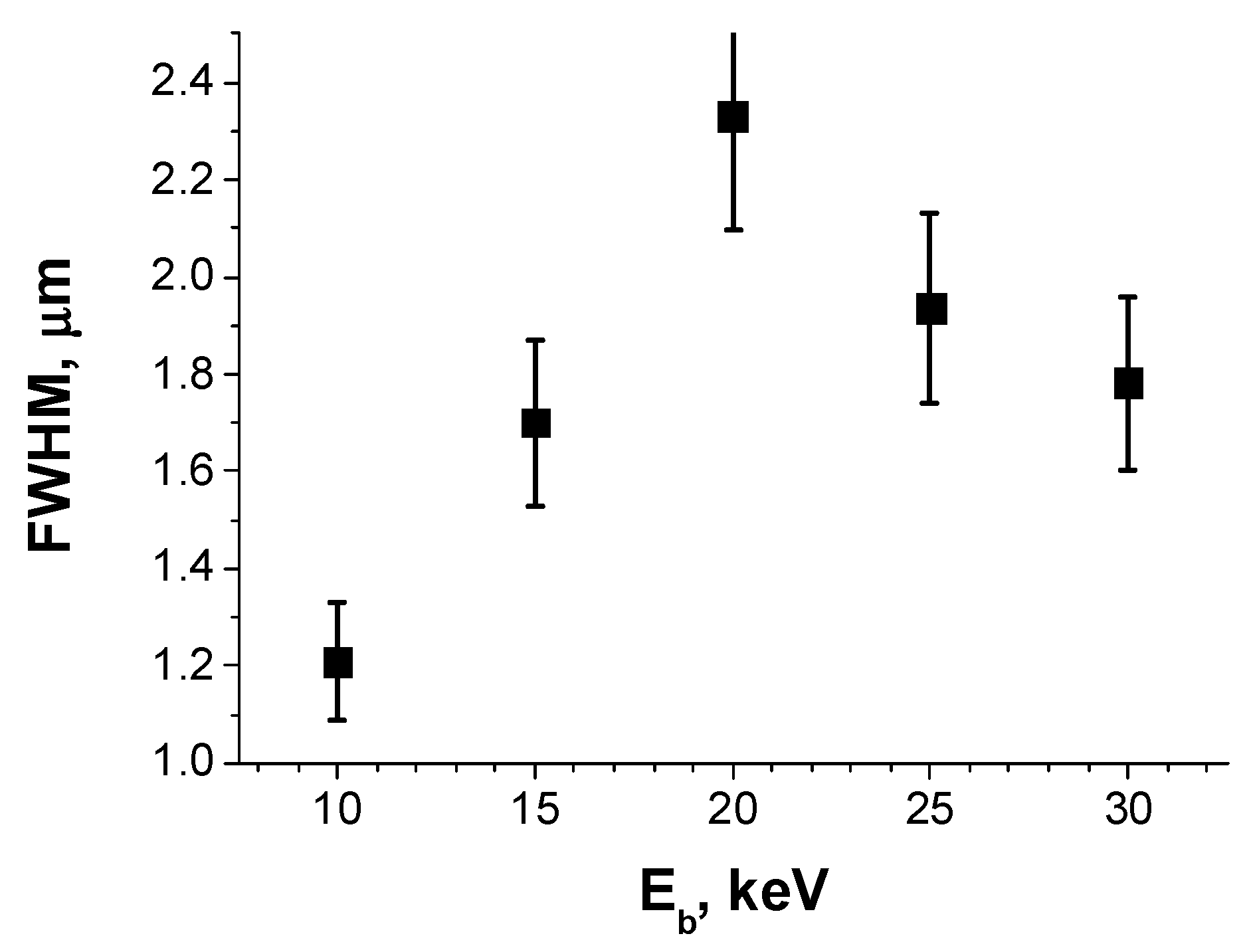
Disclaimer/Publisher’s Note: The statements, opinions and data contained in all publications are solely those of the individual author(s) and contributor(s) and not of MDPI and/or the editor(s). MDPI and/or the editor(s) disclaim responsibility for any injury to people or property resulting from any ideas, methods, instructions or products referred to in the content. |
© 2023 by the authors. Licensee MDPI, Basel, Switzerland. This article is an open access article distributed under the terms and conditions of the Creative Commons Attribution (CC BY) license (https://creativecommons.org/licenses/by/4.0/).
Share and Cite
Yakimov, E.B.; Koveshnikov, S.; Kononenko, O. EBIC Imaging of Conductive Paths Formed in Graphene Oxide as a Result of Resistive Switching. Appl. Sci. 2023, 13, 2481. https://doi.org/10.3390/app13042481
Yakimov EB, Koveshnikov S, Kononenko O. EBIC Imaging of Conductive Paths Formed in Graphene Oxide as a Result of Resistive Switching. Applied Sciences. 2023; 13(4):2481. https://doi.org/10.3390/app13042481
Chicago/Turabian StyleYakimov, Eugene B., Sergei Koveshnikov, and Oleg Kononenko. 2023. "EBIC Imaging of Conductive Paths Formed in Graphene Oxide as a Result of Resistive Switching" Applied Sciences 13, no. 4: 2481. https://doi.org/10.3390/app13042481
APA StyleYakimov, E. B., Koveshnikov, S., & Kononenko, O. (2023). EBIC Imaging of Conductive Paths Formed in Graphene Oxide as a Result of Resistive Switching. Applied Sciences, 13(4), 2481. https://doi.org/10.3390/app13042481





